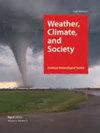美国与热浪风险认知相关的社会地理因素
IF 1.9
4区 地球科学
Q3 ENVIRONMENTAL STUDIES
引用次数: 2
摘要
极端高温事件是美国最致命的天气相关危害之一,由于人为温室气体排放,其频率和严重程度正在增加。此外,由于社会、经济和政治因素造成危险影响和应对措施的差异,一些亚群体可能比其他亚群体更脆弱。脆弱性也受到风险认知的影响,风险认知会影响保护行为。在这项研究中,我们使用全国调查数据来调查关键的社会人口因素与公众对热浪的风险认知之间的关系。我们发现,风险认知与收入、种族/民族、性别和残疾状况最为相关。年龄是热死亡的重要预测因素,与热风险认知的相关性较小。低收入、非白人和残疾人往往认为自己比其他亚群体面临更大的热浪风险,这与他们的高风险相对应。尽管男性因高温而死亡和发病率较高,但他们的风险认知低于女性。这项研究有助于确定美国认为自己有极端高温风险的亚群,并为高温风险沟通和其他降低风险的做法提供信息。本文章由计算机程序翻译,如有差异,请以英文原文为准。
Sociodemographic factors associated with heatwave risk perception in the United States
Extreme heat events are one of the deadliest weather-related hazards in the United States and are increasing in frequency and severity due to anthropogenic greenhouse gas emissions. Further, some subpopulations may be more vulnerable than others due to social, economic, and political factors that create disparities in hazard impacts and responses. Vulnerability is also affected by risk perceptions, which can influence protective behaviors. In this study, we use national survey data to investigate the association of key sociodemographic factors with public risk perceptions of heat waves. We find that risk perceptions are most associated with income, race/ethnicity, gender, and disability status. Age, an important predictor of heat mortality, had smaller associations with heat risk perceptions. Low-income, non-white, and disabled individuals tend to perceive themselves to be at greater risks from heat waves than other subpopulations, corresponding with their elevated risk. Men have lower risk perceptions than women despite their higher mortality and morbidity from heat. This study helps to identify subpopulations in the U.S. who see themselves as at risk from extreme heat and can inform heat risk communication and other risk reduction practices.
求助全文
通过发布文献求助,成功后即可免费获取论文全文。
去求助
来源期刊

Weather Climate and Society
METEOROLOGY & ATMOSPHERIC SCIENCES-
CiteScore
3.40
自引率
13.60%
发文量
95
审稿时长
>12 weeks
期刊介绍:
Weather, Climate, and Society (WCAS) publishes research that encompasses economics, policy analysis, political science, history, and institutional, social, and behavioral scholarship relating to weather and climate, including climate change. Contributions must include original social science research, evidence-based analysis, and relevance to the interactions of weather and climate with society.
 求助内容:
求助内容: 应助结果提醒方式:
应助结果提醒方式:


